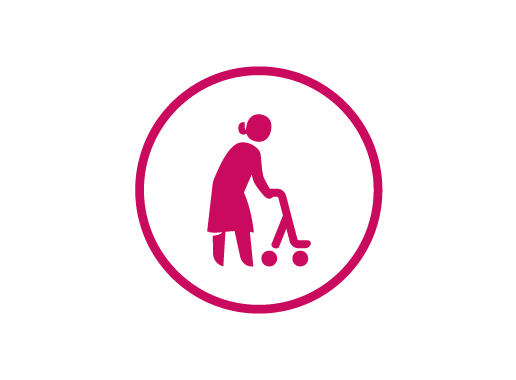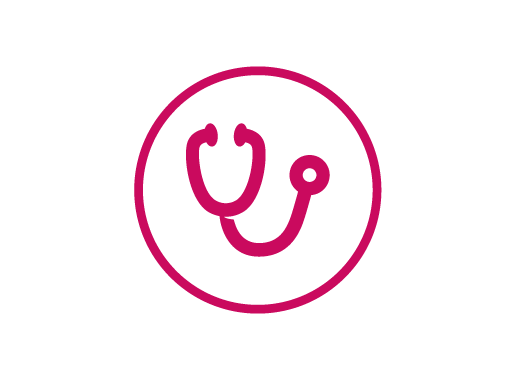
Health
How healthy will we be in the future?

The main developments in the Trend Scenario
Question 1: How healthy will we feel in the future?
- We will feel just as healthy in 2040 as we do now, despite the ageing of the population.
- A slightly larger percentage of the oldest old will feel even healthier in 2040.
Question 2: How many people will experience activity limitations in the future?
- The percentage of Dutch people who experience activity limitations will not change by 2040, despite the ageing of the population.
- The percentage of people aged 75 years and over without activity limitations will increase from 55 to 62 percent.
Question 3: How lonely will we feel in the future?
- The number of lonely people will increase, above all among people who live alone.
- The number of lonely people aged 75 years and over will increase by 700,000.
Question 4: How will we perceive our mental health in the future?
- Future developments in mental health are uncertain; however, the percentage of employees with burn-out complaints has risen slightly in recent years.
Question 5: How much control will we experience over our lives in the future?
- The number of people who experience insufficient control over their own lives will increase in the future.

How healthy will we feel in the future?
The elderly in general feel less healthy than other adults and young people. So it is logical to assume that Dutch people will on average feel less healthy in the future as a result of the ageing of the population. However, the Trend Scenario does not confirm this assumption; although our population is getting older, we will feel just as healthy in the future.
In both 2015 and 2040, almost 80 percent of the population will feel healthy. Yet, the percentage of women who feel healthy in the future will decrease slightly from 77.1 percent in 2015 to 76.4 percent in 2040.
Indicator(s) used: Percentage of Dutch people (0+) who in general perceive their health to be (very) good.
Source(s) used (in Dutch): Statistics Netherlands (CBS) Health Survey (1990 - 1996); POLS health and wellbeing (1997 - 2009); CBS Health Survey (2010 - 2014); data processed by RIVM.
Further information:
- Methods and backgrounds.
- Perceived health by age at Volksgezondheidenzorg.info (in Dutch).
According to the Trend Scenario, the oldest group of the elderly (75+) will feel slightly healthier in 2040 than people of that age do now. In 2015, 52 percent of people aged 75 years and over felt that they were in (very) good health; in 2040 this figure will be 56 percent.
In most younger age groups, the percentage of people who feel healthy will also increase very slightly. This also goes for 20-44-year-olds, the youngest group aged up to 19 years, however, will continue to feel just as healthy in the future (not shown in graph). In both 2015 and 2040, the vast majority of young people and adults perceive their health to be (very) good.
Indicator(s) used: Percentage of Dutch people (0+) who in general perceive their health to be (very) good.
Source(s) used (in Dutch): Statistics Netherlands (CBS) Health Survey (1990 - 1996); POLS health and wellbeing (1997 - 2009); CBS Health Survey (2010 - 2014); data processed by RIVM.
Futher information:
The vast majority of people (will) feel healthy both now and in the future

How many people will experience activity limitations in the future?
In general, activity limitations related to vision, hearing and mobility occur more often in elderly than in younger people. Because of the ageing of the population, it is to be expected that the percentage of Dutch people with activity limitations will increase in the future. However, the Trend Scenario shows that in 2015 and 2040 an equal proportion of the Dutch population above 16 years will not experience any activity limitations regarding vision, hearing or mobility. This is true for both men and women. The percentage of women without activity limitations will also be smaller in the future than the percentage of men. The vast majority of Dutch people (over 86 percent) did not experience any activity limitations in 2015 and will not do so in 2040.
Indicator(s) used: Percentage of Dutch people (16+) who experience no activity limitations related to vision, hearing and mobility.
Source(s) used (in Dutch): Statistics Netherlands (CBS) Health Survey (1990 - 1996); POLS health and wellbeing (1997 - 2009); CBS Health Survey (2010 - 2014); data processed by RIVM.
Further information:
- Methods and backgrounds.
- Functioning problems at Volksgezondheidenzorg.info (in Dutch).
The Trend Scenario shows that, in the future, an increasingly smaller proportion of people aged 45 and over will experience activity limitations related to vision, hearing and mobility. This is mainly due to a decrease in mobility limitations (not shown in graph).
The differences between 2015 and 2040 will be the greatest among people aged 75 years and over. The percentage of people aged 75 years and over without activity limitations will increase from 55 percent in 2015 to 62 percent in 2040. A possible explanation for this trend might be that the elderly quite simply have the most to gain. In addition, physical aids and devices such as mobility scooters, spectacles, hearing aids and assistive domotics, are becoming increasingly better. However, the absolute number of people aged 75 years and above with one or more activity limitations will increase from 590,000 in 2015 to 1 million in 2040.
Indicator(s) used: Percentage of Dutch people (16+) who experience no activity limitations related to vision, hearing and mobility.
Source(s) used (in Dutch): Statistics Netherlands (CBS) Health Survey (1990 - 1996); POLS health and wellbeing (1997 - 2009); CBS Health Survey (2010 - 2014); data processed by RIVM.
Futher information:
The percentage of Dutch people without activity limitations will remain the same in the future

How lonely will we feel in the future?
The Trend Scenario shows that the number of lonely Dutch people aged 19 years and over will increase in the future. In the future, the number of lonely people who live alone will increase more than the number of lonely people who cohabit. This applies to both moderately lonely and seriously lonely people. In total, the number of lonely people will increase from 5.2 million in 2015 to almost 5.9 million in 2040 (41 percent of adults). This is an increase of 700,000 lonely people. Most of these people feel moderately lonely, but serious loneliness will also be more common in the future. The number of seriously lonely people as a percentage of all lonely people will hardly change between 2015 and 2040. Reasons for the future increase in the number of lonely people are the ageing of the population and rising numbers of single-person households (loneliness occurs more among people who live alone than among people who cohabit). Although loneliness is a problem for all ages, it tends to increase with age.
Indicator(s) used: Number of Dutch people (19+) who feel moderately or seriously lonely according to the Dutch 11-item loneliness scale.
Source(s) used(in Dutch): Health Monitor for adults, Public Health Services, Statistics Netherlands (CBS) and RIVM, 2012.
Further information:
- Methods and backgrounds.
- Loneliness by age and marital status at Volksgezondheidenzorg.info (in Dutch).
The Trend Scenario shows that the number of lonely Dutch people will increase above all among people aged 75 years and over. They are people who feel moderately or seriously lonely. The number of lonely people aged 75 years and over will increase from over 600,000 in 2015 to over 1.3 million in 2040 (50 percent of people aged 75 years and over).
Among 65-74-year-olds too, the number of lonely people will increase in the future, whereas the number of lonely people in the age group 45 - 64 years will decrease. The increase in the number of lonely people among those aged 75 years and over is related to the ageing of the population. There will be relatively more very old elderly people in the future, and loneliness is most common among the oldest old.
Indicator(s) used: Number of Dutch people (19+) who feel moderately or seriously lonely according to the Dutch 11-item loneliness scale.
Source(s) used (in Dutch): Health Monitor for adults, Public Health Services, Statistics Netherlands (CBS) and RIVM, 2012.
Futher information:
- Methods and backgrounds.
- Loneliness by age at Volksgezondheidenzorg.info (in Dutch).
In 2040, 5.9 million people will feel lonely

How will we perceive our mental health in the future?
Between 2007 and 2015, the percentage of employees who report burn-out complaints rose slightly. This is shown by the TNO’s Netherlands Working Conditions Survey (NEA). The number of notifications of emotional exhaustion and burn-out by company doctors rose dramatically between 2012 and 2015. These notifications were registered with the Netherlands Center for Occupational Diseases.
In general, most of the population aged 12 years and older experience no mental distress. This is evidenced by data from the Mental Health Inventory (MHI-5), a 5-item questionnaire about how people felt over the last four weeks. Statistics Netherlands (CBS) has been using this questionnaire since 2001. The MHI provides a more general and broader picture of mental health than just burn-out complaints. The historic trend in mental distress based on the MHI-5 in the past does not provide a clear picture. Although burn-out complaints among employees appear to be on the increase, the future development of mental complaints in the general population is unclear.
Indicator(s) used: Emotional exhaustion because of work.
Source(s) used (in Dutch): TNO Netherlands Working Conditions Survey (NEA) 2007-2015.
Further information:
- Methods and backgrounds.
- Trends in emotional exhaustion and burn-out at Volksgezondheidenzorg.info (in Dutch).
Burn-out complaints among employees increased in recent years

How much control will we experience over our lives in the future?
The Trend Scenario shows that in the future increasing numbers of people will experience insufficient control over their own lives. This increase applies to both men and women, with women showing a higher increase than men. Between 2015 and 2040 the number of people who experience insufficient control will increase from 1.3 million to 1.6 million. This will be mainly attributable to the ageing of the population. In general elderly people experience less control over their lives than young people (not shown in graph). On average, men experience slightly more control than women.
Indicator(s) used: Number of Dutch people (19+) who experience insufficient control over their lives.
Source(s) used (in Dutch): Health Monitor for adults, Public Health Services, Statistics Netherlands (CBS) and RIVM, 2016.
Further information:
In the future increasing numbers of people will experience insufficient control over their lives
This Trend Scenario is part of the Public Health Foresight study 2018 (VTV-2018), and was published in July 2017. In December 2017, Thematic Foresight Studies on Health on Future health care demand, Wider determinants of health and Technology were published. In June 2018, the final products of the VTV-2018 became available. These are Options for Action for selected urgent societal challenges, and a Synthesis including key messages.
The VTV Trend Scenario presents figures about the future. Figures and information about historical trends and the current state of affairs can be found on the websites (in Dutch) De Staat van Volksgezondheid and Volksgezondheidenzorg.info.


